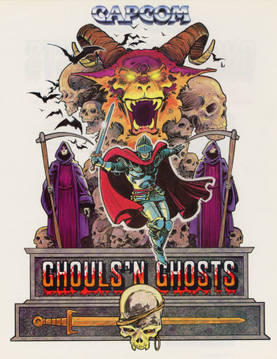
Ghouls 'n Ghosts, known as Dai Makaimura in Japan, is a 1988 platform video game developed and published by Capcom for arcades. It is the sequel to Ghosts 'n Goblins and the second game in the Ghosts 'n Goblins series.

Street Fighter II: The World Warrior is a 1991 fighting game developed and published by Capcom for arcades. It is the second installment in the Street Fighter series and the sequel to 1987's Street Fighter. It is the fourteenth game to use Capcom's CP System arcade system board. Street Fighter II vastly improved many of the concepts introduced in the first game, including the use of special command-based moves, a combo system, a six-button configuration, and a wider selection of playable characters, each with a unique fighting style.

Super Street Fighter II: The New Challengers is a 1993 fighting game developed and published by Capcom for arcades. It is the fourth game in the Street Fighter II sub-series of Street Fighter games, following Street Fighter II Turbo (1992). It refines and balances the existing character roster from the previous versions, and introduces four new characters, including Cammy and Dee Jay. It is the first game on Capcom's CP System II hardware, with more sophisticated graphics and audio over the original CP System hardware used in previous versions of Street Fighter II.

X-Men vs. Street Fighter is a crossover fighting video game developed and published by Capcom. It is Capcom's third fighting game to feature Marvel Comics characters, following X-Men: Children of the Atom and Marvel Super Heroes, and is the first installment in the Marvel vs. Capcom series. As the title suggests, the game includes characters from Marvel's X-Men franchise and the cast from Capcom's Street Fighter series. Originally released as a coin-operated arcade game in 1996, it was ported to the Sega Saturn in 1997 and the PlayStation in 1998. The original arcade version is included in the game lineup for Marvel vs. Capcom Fighting Collection: Arcade Classics, released for the Nintendo Switch, PlayStation 4 and Windows in 2024.
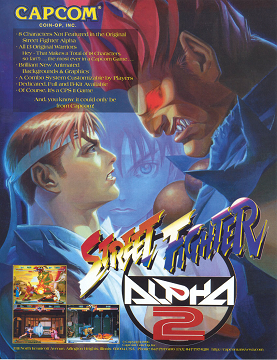
Street Fighter Alpha 2, known as Street Fighter Zero 2 in Japan, Asia, South America, and Oceania, is a 1996 fighting game originally released for the CPS II arcade hardware by Capcom. The game is a remake of the previous year's Street Fighter Alpha: Warriors' Dreams and features a number of improvements, such as new attacks, stages, endings, and gameplay features. It was ported to the PlayStation, Sega Saturn and Super Nintendo home consoles globally in 1996, and later a Windows port. It was followed by Street Fighter Alpha 3 in 1998.
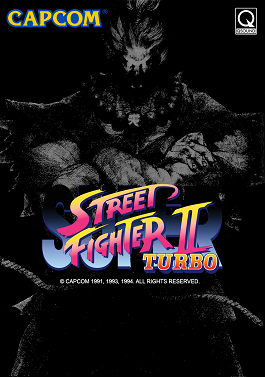
Super Street Fighter II Turbo, released in Japan as Super Street Fighter II X: Grand Master Challenge is a 1994 fighting game developed and published by Capcom for arcades. It is the fifth installment in the Street Fighter II sub-series of Street Fighter games, following Super Street Fighter II (1993). Like its predecessor, it ran on the CP System II hardware.

Street Fighter Alpha 3, released as Street Fighter Zero 3 in Japan, Asia, South America, and Oceania, is a 2D fighting game originally released by Capcom for the arcade in 1998. It is the third and final installment in the Street Fighter Alpha sub-series, which serves as a sequel to Street Fighter Alpha 2, and ran on the same CP System II hardware as previous Alpha games. The game was produced after the Street Fighter III sub-series has started, being released after 2nd Impact, but before 3rd Strike. Alpha 3 further expanded the playable fighter roster from Street Fighter Alpha 2 and added new features such as selectable fighting styles called "isms".

X-Men: Children of the Atom is a 1994 fighting game developed and published by Capcom and released on the CP System II arcade hardware. It was released in December 1994 in Japan and in January 1995 in North America and Europe.

Super Puzzle Fighter II Turbo, released in Japan as Super Puzzle Fighter II X, is a tile-matching puzzle video game released in 1996 for the CP System II (CPS2) arcade board, by Capcom and its Capcom Coin-Op division. The game's title is a play on Super Street Fighter II Turbo, as there were no other Puzzle Fighter games at the time, and the game includes music and interface elements spoofing the Street Fighter Alpha and Darkstalkers games. It was a response to Sega's Puyo Puyo 2 that had been sweeping the Japanese arcade scene.
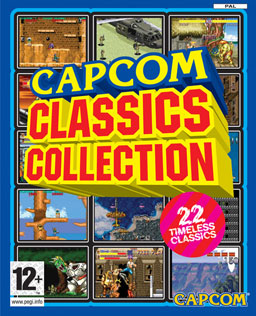
Capcom Classics Collection is a video game compilation developed and published by Capcom for the PlayStation 2 and Xbox. It was developed by Backbone Entertainment, Sensory Sweep, and its Japanese developer Klein Computer Entertainment. A second volume, Capcom Classics Collection Vol. 2, was released on November 14, 2006 in North America, for PlayStation 2 and Xbox. The second volume as well as the Xbox version of the first volume were not released in Japan.

Street Fighter II Turbo: Hyper Fighting is a 1992 fighting game developed and published by Capcom for arcades. It is the third arcade version of Street Fighter II, part of the Street Fighter franchise, following Street Fighter II: Champion Edition, and was initially released as an enhancement kit for that game. Released less than a year after the previous installment, Turbo introduced a faster playing speed and new special moves for certain characters, as well as further refinement to the character balance.

Street Fighter Collection is a 1997 fighting game compilation developed and published by Capcom for the Sega Saturn and PlayStation. It contains the original Super Street Fighter II: The New Challengers (1993), its follow-up Super Street Fighter II Turbo (1994), and an enhanced version of Street Fighter Alpha 2 titled Street Fighter Alpha 2 Gold, which is exclusive to this compilation.

Street Fighter Alpha: Warriors' Dreams, known as Street Fighter Zero in Japan, Asia, South America, and Oceania, is a 2D arcade fighting game by Capcom originally released in 1995 for the CP System II hardware. It was the first all new Street Fighter game produced by Capcom since the release of Street Fighter II in 1991. Plotwise, it serves as a prequel to Street Fighter II and thus features younger versions of established characters, as well as characters from the original Street Fighter and Final Fight.

Street Fighter is a Japanese media franchise centered on a series of fighting games developed and published by Capcom. The first game in the series was released in 1987, followed by six other main series games, various spin-offs and crossovers, and numerous appearances in other media. Its best-selling 1991 release Street Fighter II established many of the conventions of the one-on-one fighting genre.
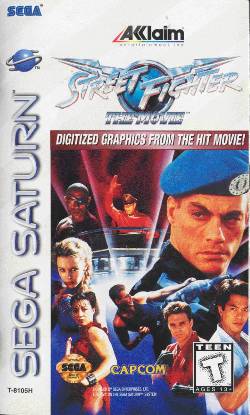
Street Fighter: The Movie is a 2D head-to-head fighting game developed by Capcom, released for the PlayStation and Sega Saturn in 1995, with the game serving as a North American launch title for the PlayStation. The game is based on the 1994 live-action Street Fighter movie, itself based on the Street Fighter series of fighting games, and uses digitized images of the film's cast as the characters. While it shares its title with the arcade game Street Fighter: The Movie, the home version is not a port but a similar game developed on the same premise. The game was a commercial success but a critical failure, receiving negative reviews from critics.

Street Fighter: The Movie is a 1995 fighting game released as an arcade game. The game is based on the 1994 live-action Street Fighter film, itself based on the Street Fighter series of fighting games, and uses digitized images of the film's cast. The game was developed by Chicago-based Incredible Technologies and distributed to the arcades by Capcom. The game was widely panned by critics.
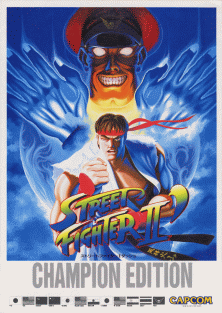
Street Fighter II: Champion Edition, released as Street Fighter II Dash in Japan, is a 1992 fighting game developed and publishes by Capcom for arcades. It is the first of several updated versions of Street Fighter II, and part of the Street Fighter series. The main changes are the addition of the four grand masters as playable characters and mirror matches. The fighting techniques of the eight main characters from the original game were further balanced for competitive play.

Ultra Street Fighter II: The Final Challengers is a 2017 2D fighting game developed and published by Capcom for the Nintendo Switch. Released to celebrate the Street Fighter series' 30th anniversary, it is an updated version of Super Street Fighter II Turbo (1994), itself an update of Street Fighter II (1991). The game features two graphical styles: classic pixel art and updated high-definition art. New gameplay mechanics and modes were also introduced, with minor changes being made to the game's balance. The game garnered mixed-to-positive reviews from critics, who praised its updated visuals, but criticized its price, the Way of the Hado mode, and control problems.

Street Fighter 30th Anniversary Collection is a compilation of fighting games from the Street Fighter series developed by Digital Eclipse and published by Capcom in celebration of the series' 30th anniversary. The collection was released for Nintendo Switch, PlayStation 4, Windows, and Xbox One in May 2018.



















